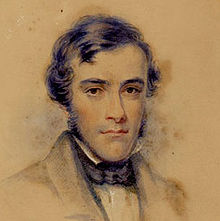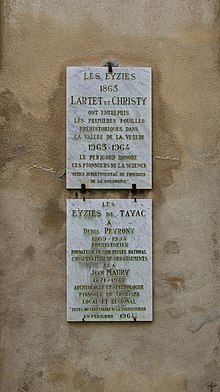Henry Christy
Henry Christy | |
|---|---|
 | |
| Born | 26 July 1810 |
| Died | 4 May 1865 (aged 54) |
| Nationality | British |
| Occupation | Banker |
| Employer | London Joint-Stock Bank |
| Known for | Ethnographic collection, British Museum |
Henry Christy (26 July 1810 – 4 May 1865) was an English banker and collector, who left his substantial collections to the British Museum.
Early life
Christy was born at
Trained to business by his father, Henry Christy became a partner in the house of Christy & Co. in
Interests
Christy was a philanthropist, active in the
Christy was also involved in numerous learned societies. He belonged to both the
Travels and collecting
In 1850 Christy began to visit foreign countries. Among the fruits of his first expedition to the East were an extensive collection of Eastern fabrics, and a large series of figures from Cyprus, which are now in the British Museum.[2]
After the

In 1858, the
Death
In April 1865, Christy left England with a small party of geologists to examine some caves which had recently been discovered in Belgium, near Dinant. While at work he caught a severe cold. A subsequent journey with M. and Mme. Lartet to La Palisse brought on inflammation of the lungs, of which he died on 4 May 1865.[2]
Collections and legacy
By his will, Christy bequeathed his collections of modern objects to the nation; his archaeological collection went to the nation, but with the finds from excavations in France to be shared with the French
Christy had a partial catalogue of his collections made in 1862, by
References
- ^ Humphrey Lloyd. The Quaker Lloyds in the Industrial Revolution 1660–1860 (2006), p. 285; Google Books.
- ^ a b c d e f g Harrison 1887.
- ^ The Bankers' Magazine, and journal of the money market (1865), p. 180; archive.org.
- ^ John Rylands University Library- Papers of W.M. Christy & Sons Ltd
- ^ Jonathan C. H. King, First Peoples, First Contacts: native peoples of North America (1999), p. 218; Google Books.
- ISBN 978-0-7735-0959-7. Retrieved 24 April 2012.
- ISBN 978-0-7735-0959-7. Retrieved 24 April 2012.
- JSTOR 3014240.
- ISBN 978-0-252-03183-0.
- )
- JSTOR 2799027.
- ^ Proceedings of the Linnean Society of London (1855-63), p. v; archive.org.
- doi:10.1093/ref:odnb/5375. (Subscription or UK public library membershiprequired.)
- ^ Andrew L. Christenson, Tracing Archaeology's Past: the historiography of archaeology (1989), pp. 158–9; Google Books.
- ^ Mark Bowden, Pitt Rivers: the life and archaeological work of Lieutenant-General Augustus Henry Lane Fox Pitt Rivers, DCL, FRS, FSA (1991), p. 48; Google Books.
- ^ Acquisition note, British Museum
- ^ a b Christy Fund, British Museum, accessed August 2010
- ^ British Museum, biography of Christy.
Attribution
![]() This article incorporates text from a publication now in the public domain: Harrison, William Jerome (1887). "Christy, Henry". In Stephen, Leslie (ed.). Dictionary of National Biography. Vol. 10. London: Smith, Elder & Co. pp. 295–296.
This article incorporates text from a publication now in the public domain: Harrison, William Jerome (1887). "Christy, Henry". In Stephen, Leslie (ed.). Dictionary of National Biography. Vol. 10. London: Smith, Elder & Co. pp. 295–296.
